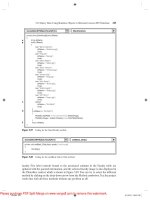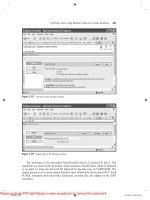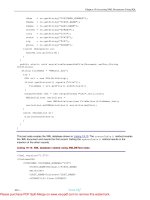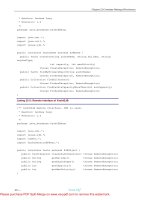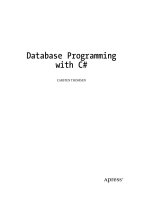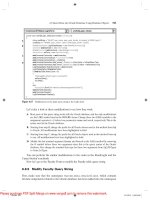Java Database Programming with JDBC docx
Bạn đang xem bản rút gọn của tài liệu. Xem và tải ngay bản đầy đủ của tài liệu tại đây (1.21 MB, 373 trang )
Java Database Programming with
JDBC
by Pratik Patel
Coriolis, The Coriolis Group
ISBN: 1576100561 Pub
Date: 10/01/96
Table of Contents
Introduction
Welcome to the future of database connectivity. The Java Database Connectivity ( JDBC ) specification is a new basis
for developers to interface with data sources. The structure of the JDBC is designed to allow developers to program for a
standard interface, and let the low-level JDBC driver for different databases deal with the connection and querying of the
databases; hence, the developer does not need to worry about dealing with different SQL flavors for each database. The
JDBC is also very flexible—a developer doesn’t necessarily lose features specific to the target database. Best of all, the
JDBC is based on the Java language!
Getting Software
The software that you’ll need to get started with the JDBC is readily available on the Web. The JDBC drivers that you
will need to connect to your databases are currently available for most popular databases from a variety of software
vendors. The basic package you’ll need is the JDBC API, which consists of the core classes of the JDBC. If you don’t
already have a Java development kit, such as Javasoft’s JDK, you’ll need that as well. At the time this manuscript was
finished, the examples in the book were tested with the JavaSoft JDK, Symantec Cafe, Microsoft J++, and Borland’s C+
+ 5.0 with Java support. You can get the JavaSoft JDK at .
The JDBC API, and the ODBC driver for JDBC (that’s right, you can use the JDBC with your current ODBC drivers!)
commonly referred to as the JDBC-ODBC bridge can be downloaded at the JDBC Web site at
/>jdbc. You’ll also find the documentation for the JDBC API at this Web site. If you want to see some of the original
JDBC specification, this can be downloaded from the JDBC Web site as well.
Overview of Chapters
Chapter 1, JDBC: Databases, The Java Way!, begins with a high-level introduction to the JDBC. You’ll see how
modular JDBC drivers fit into the development cycle, as well as where ODBC fits into the JDBC’s overall structure.
Chapter 2, SQL 101: An Introduction To SQL, takes a quick stroll through SQL, the language of databases. This chapter
is a primer on SQL, and is useful if you need to brush up on your data-speak. It provides a basis of reference for some of
the SQL queries performed in the JDBC programs in the book.
Chapter 3, Using JDBC Drivers, shows you how to install JDBC drivers, as well as how to handle the installation of the
JDBC API base classes. A “quick start” section also prepares you for what’s ahead by giving you a simple, but complete
JDBC program.
Chapter 4, The Interactive SQL Query Applet, takes you head first into the JDBC by presenting a complete Java applet
that uses the JDBC. The applet allows a user to enter SQL queries and run them against a database, and to show the
results.
Chapter 5, Accessing ODBC Services Using JDBC, takes a look at the JDBC-ODBC bridge in detail. Limitations of the
bridge, as well as a complete listing of the features of ODBC available in the JDBC, are presented.
Chapter 6, SQL Datatypes In Java And ORM, shows you how to map SQL datatypes into Java, and provides a discussion
of some of the special classes available in the JDBC API that facilitate the exchange of data between your Java program
and the database.
Chapter 7, Working With Query Results, provides a pathway for using results fetched from a SQL query. The complete
cycle of querying a database, formatting the results, and displaying or printing them in nice graphs is presented with
complete source code. A bar graph and pie chart are dynamically created in an applet using data from a query.
Chapter 8, The Multimedia JDBC Application: Icon Store, continues the discussion in Chapter 7 by expanding into the
realm of multimedia. Streams that contain binary data, such as images, are the focus of this chapter. We’ll show you how
to store and retrieve binary data from a database, using the methods available in the JDBC.
Chapter 9, Java and Database Security, reflects on the security consideration you need to ponder before you put your
JDBC programs into production. The issue of “applet trusting,” and more, is covered in this chapter.
Chapter 10, Writing Database Drivers, takes you into the heart of the JDBC with a thorough discussion of the
programming details of JDBC drivers. You’ll even see an actual JDBC driver produced, as our SimpleText JDBC driver
is hammered out during the chapter. The full source code for this driver is presented in Appendix B, while the intricacies
of writing a JDBC driver are explained in detail in this chapter.
Chapter 11, Internet Database Issues: Middleware, details three-tier database systems. A three-tier system is developed
in this chapter to give you an idea of the functionality possible with these types of “indirect” database access. The full
source code for the developed application server and the client are presented, as well as a sample applet that uses the
client to query and obtain results from a database.
Chapter 12, The JDBC API, provides you with a reference for all of the methods, variables, classes, exceptions, and
interfaces that are the JDBC.
Table of Contents
Java Database Programming with
JDBC
by Pratik Patel
Coriolis, The Coriolis Group
ISBN: 1576100561 Pub
Date: 10/01/96
Introduction
Chapter 1—JDBC: Databases The Java Way!
What Is The JDBC?
The JDBC Structure
ODBC’s Part In The JDBC
Summary
Chapter 2—SQL 101
The Relational Model And SQL
Understanding The Basics
Putting It Into Perspective: Schema And Catalog
Introducing Keys
Using Multiple Tables And Foreign Keys
Data Definition Language
Declaring Domains
Performing Checks
Creating Tables
Manipulating Tables
Data Maintenance Language
Data Query Language
Coming Up Next
Chapter 3—Using JDBC Drivers
Quick Start Guide
Installing java.sql.*
Registering And Calling JDBC Drivers
The sql.drivers Property
There’s Always A Class For A Name
Just Do It
JDBC URL And The Connection
Using ODBC Drivers
Installing The JDBC-ODBC Bridge
Setting Up ODBC Drivers
Summary
Chapter 4—The Interactive—SQL Applet
Your First JDBC Applet
The Blueprint
Getting A Handle On The JDBC Essentials: The Complete Applet Source Code
The Look Of The Applet
Handling Events
Opening The Connection
No Guts, No Glory: Executing Queries And Processing Results
Wrapping It Up
The HTML File That Calls The Applet
The Final Product
Coming Up Next
Chapter 5—Accessing ODBC Services Using JDBC
Bridge Requirements
The Bridge Is Great, But
The ODBC URL
JDBC To ODBC Calls: A Roadmap
Chapter 6—SQL Data Types In Java And ORM
Mapping SQL Data To Java
ResultSetMetaData
Understanding The Object Relation Model
Mapping A Table Into A Java Object
Summary
Chapter 7—Working With Query Results
A Basic Java Object For Storing Results
Showing The Results
Charting Your Data
Summary
Chapter 8—The IconStore Multimedia JDBC Application
IconStore Requirements
Building The Database
Application Essentials
Writing The main Method
Establishing The Database Connection
Creating The Menu
Creating The Lists
Handling Events
Saving The Image
Summary
Chapter 9—Java And Database Security
Database Server Security
Rooting Out The Packet Sniffers
Web Server CGI Holes
Finding A Solution
Applet Security: Can I Trust You?
The Applet Security Manager
I’m A Certified Applet
Summary
Chapter 10—Writing Database Drivers
The JDBC Driver Project: SimpleText
SimpleText SQL Grammar
SimpleText File Format
The DriverManager
JDBC Exception Types
JDBC Data Types
Character Data: CHAR, VARCHAR, And LONGVARCHAR
Exact Numeric Data: NUMERIC And DECIMAL
Binary Data: BINARY, VARBINARY, And LONGVARBINARY
Boolean Data: BIT
Integer Data: TINYINT, SMALLINT, INTEGER, And BIGINT
Floating-Point Data: REAL, FLOAT, And DOUBLE
Time Data: DATE, TIME, And TIMESTAMP
New Data Classes
Numeric
Date
Time
Timestamp
Native Drivers: You’re Not From Around Here, Are Ya?
Implementing Interfaces
Tracing
Turning On Tracing
Writing Tracing Information
Checking For Tracing
Data Coercion
Escape Clauses
Date, Time, And Timestamp
Scalar Functions
LIKE Predicate Escape Characters
Outer Joins
Procedures
The JDBC Interfaces
Driver
Connection
DatabaseMetaData
Statement
PreparedStatement
ResultSet
ResultSetMetaData
Summary
Chapter 11—Internet Database Issues: Middleware
Connectivity Issues Involved With Database Access
Advantages Of Middleware
Disadvantages Of Middleware
The Application Server: A Complete Example With Code
The Client: A Complete Example With Code
Summary
Chapter 12—The JDBC API
Classes
public class Date
public class DriverManager
public class DriverPropertyInfo
public final class Numeric
public class Time
public class TimeStamp
public class Types
Interfaces
public interface CallableStatement
public interface Connection
public interface DatabaseMetaData
public interface Driver
public interface PreparedStatement
public interface ResultSet
public interface ResultSetMetaData
public interface Statement
Exceptions
public class DataTruncation
public class SQLException
public class SQLWarning
Appendix A
Appendix B
Appendix C
Appendix D
Index
Java Database Programming with
JDBC
by Pratik Patel
Coriolis, The Coriolis Group
ISBN: 1576100561 Pub
Date: 10/01/96
Previous Table of Contents Next
Chapter 1
JDBC: Databases The Java Way!
The Internet has spurred the invention of several new technologies in client/server computing—the most recent of which
is Java. Java is two-dimensional: It’s a programming language and also a client/server system in which programs are
automatically downloaded and run on the local machine (instead of the server machine). The wide embrace of Java has
prompted its quick development. Java includes Java compilers, interpreters, tools, libraries, and integrated development
environments (IDEs). Javasoft is leading the way in the development of libraries to extend the functionality and usability
of Java as a serious platform for creating applications. One of these libraries, called Application Programming Interfaces
(APIs), is the Java Database Connectivity API, or JDBC. Its primary purpose is to intimately tie connectivity to
databases with the Java language.
We’ll discuss the reasoning behind the JDBC in this chapter, as well as the design of the JDBC and its associated API.
The Internet, or better yet, the technologies used in the operation of the Internet, are tied into the design of the JDBC.
The other dominant design basis for the JDBC is the database standard known as SQL. Hence, the JDBC is a fusion of
three discrete computer areas: Java, Internet technology, and SQL. With the growing implementation of these Internet
technologies in “closed” networks, called intranets, the time was right for the development of Java-based enterprise
APIs. In this book, intranet and Internet are both used to describe the software technology behind the network, such as
the World Wide Web.
What Is The JDBC?
As I mentioned a moment ago, JDBC stands for Java Database Connectivity. What is this JDBC besides a nifty
acronym? It refers to several things, depending on context:
• It’s a specification for using data sources in Java applets and applications.
• It’s an API for using low-level JDBC drivers.
• It’s an API for creating the low-level JDBC drivers, which do the actual connecting/transacting with data
sources.
• It’s based on the X/Open SQL Call Level Interface (CLI) that defines how client/server interactions are
implemented for database systems.
Confused yet? It’s really quite simple: The JDBC defines every aspect of making data-aware Java applications and
applets. The low-level JDBC drivers perform the database-specific translation to the high-level JDBC interface. This
interface is used by the developer so he doesn’t need to worry about the database-specific syntax when connecting to and
querying different databases. The JDBC is a package, much like other Java packages such as java.awt. It’s not currently
a part of the standard Java Developer’s Kit (JDK) distribution, but it is slated to be included as a standard part of the
general Java API as the java.sql package. Soon after its official incorporation into the JDK and Java API, it will also
become a standard package in Java-enabled Web browsers, though there is no definite timeframe for this inclusion. The
exciting aspect of the JDBC is that the drivers necessary for connection to their respective databases do not require any
pre-installation on the clients: A JDBC driver can be downloaded along with an applet!
The JDBC project was started in January of 1996, and the specification was frozen in June of 1996. Javasoft sought the
input of industry database vendors so that the JDBC would be as widely accepted as possible when it was ready for
release. And, as you can see from this list of vendors who have already endorsed the JDBC, it’s sure to be widely
accepted by the software industry:
• Borland International, Inc.
• Bulletproof
• Cyber SQL Corporation
• DataRamp
• Dharma Systems, Inc.
• Gupta Corporation
• IBM’s Database 2 (DB2)
• Imaginary (mSQL)
• Informix Software, Inc.
• Intersoft
• Intersolv
• Object Design, Inc.
• Open Horizon
• OpenLink Software
• Oracle Corporation
• Persistence Software
• Presence Information Design
• PRO-C, Inc.
• Recital Corporation
• RogueWave Software, Inc.
• SAS Institute, Inc. ™
• SCO
• Sybase, Inc.
• Symantec
• Thunderstone
• Visigenic Software, Inc.
• WebLogic, Inc.
• XDB Systems, Inc.
The JDBC is heavily based on the ANSI SQL-92 standard, which specifies that a JDBC driver should be SQL-92 entry-
level compliant to be considered a 100 percent JDBC-compliant driver. This is not to say that a JDBC driver has to be
written for an SQL-92 database; a JDBC driver can be written for a legacy database system and still function perfectly.
As a matter of fact, the simple JDBC driver included with this book uses delimited text files to store table data. Even
though the driver does not implement every single SQL-92 function, it is still a JDBC driver. This flexibility will be a
major selling point for developers who are bound to legacy database systems but who still want to extend their client
applications.
Previous Table of Contents Next
Java Database Programming with
JDBC
by Pratik Patel
Coriolis, The Coriolis Group
ISBN: 1576100561 Pub
Date: 10/01/96
Previous Table of Contents Next
The JDBC Structure
As I mentioned at the beginning of this chapter, the JDBC is two-dimensional. The reasoning for the split is to separate
the low-level programming from the high-level application interface. The low-level programming is the JDBC driver.
The idea is that database vendors and third-party software vendors will supply pre-built drivers for connecting to
different databases. JDBC drivers are quite flexible: They can be local data sources or remote database servers. The
implementation of the actual connection to the data source/database is left entirely to the JDBC driver.
The structure of the JDBC includes these key concepts:
• The goal of the JDBC is a DBMS independent interface, a “generic SQL database access framework,” and a
uniform interface to different data sources.
• The programmer writes only one database interface; using JDBC, the program can access any data source
without recoding.
Figure 1.1 shows the architecture of the JDBC. The DriverManager class is used to open a connection to a database via
a JDBC driver, which must register with the DriverManager before the connection can be formed. When a connection
is attempted, the DriverManager chooses from a given list of available drivers to suit the explict type of database
connection. After a connection is formed, the calls to query and fetch results are made directly with the JDBC driver.
The JDBC driver must implement the classes to process these functions for the specific database, but the rigid
specification of the JDBC ensures that the drivers will perform as expected. Essentially, the developer who has JDBC
drivers for a certain database does not need to worry about changing the code for the Java program if a different type of
database is used (assuming that the JDBC driver for the other database is available). This is especially useful in the
scenario of distributed databases.
Figure 1.1 The architecture of the JDBC.
The JDBC uses a URL syntax for specifying a database. For example, a connection to a mSQL database, which was used
to develop some of the Java applets in this book, is:
jdbc:msql://mydatabase.server.com:1112/testdb
This statement specifies the transport to use (jdbc), the database type (msql), the server name, the port (1112), and the
database to connect to (testdb). We’ll discuss specifying a database more thoroughly in Chapter 3.
The data types in SQL are mapped into native Java types whenever possible. When a native type is not present in Java, a
class is available for retrieving data of that type. Consider, for example, the Date type in the JDBC. A developer can
assign a date field in a database to a JDBC Date class, after which the developer can use the methods in the Date class to
display or perform operations. The JDBC also includes support for binary large objects, or BLOB data types; you can
retreive and store images, sound, documents, and other binary data in a database with the JDBC. In Chapter 6, we’ll
cover the SQL data types and their mapping into Java/JDBC, as well object-relational mapping.
ODBC’s Part In The JDBC
The JDBC and ODBC share a common parent: Both are based on the same X/OPEN call level interface for SQL.
Though there are JDBC drivers emerging for many databases, you can write database-aware Java programs using
existing ODBC drivers. In fact, Javasoft and Intersolv have written a JDBC driver—the JDBC-ODBC Bridge—that
allows developers to use exisiting ODBC drivers in Java programs. Figure 1.2 shows the place of the JDBC-ODBC
Bridge in the overall architecture of the JDBC. However, the JDBC-ODBC Bridge requires pre-installation on the client,
or wherever the Java program is actually running, because the Bridge must make native method calls to do the
translation from ODBC to JDBC. This pre-installation issue is also true for JDBC drivers that use native methods. Only
100 percent Java JDBC drivers can be downloaded across a network with a Java applet, thus requiring no pre-installation
of the driver.
Figure 1.2 ODBC in the JDBC model.
ODBC drivers function in the same manner as “true” JDBC drivers; in fact, the JDBC-ODBC bridge is actually a
sophisticated JDBC driver that does low-level translation to and from ODBC. When the JDBC driver for a certain
database becomes available, you can easily switch from the ODBC driver to the new JDBC driver with few, if any,
changes to the code of the Java program.
Summary
The JDBC is not only a specification for using data sources in Java applets and applications, but it also allows you to
create and use low-level drivers to connect and “talk” with data sources. You have now explored the JDBC architecture
and seen how the ODBC fits into the picture. The important concept to remember about the JDBC is that the modular
design of the JDBC interface allows you to change between drivers—hence databases—without recoding your Java
programs.
In the next chapter, we’ll take a step back to give you a quick primer on SQL, one of the pillars of the JDBC. If you are
already familiar with SQL-92, feel free to skip the chapter. However, I think that you may find the chapter helpful in
clarifying the SQL queries performed in the sample JDBC programs we develop in this book.
Previous Table of Contents Next
Java Database Programming with
JDBC
by Pratik Patel
Coriolis, The Coriolis Group
ISBN: 1576100561 Pub
Date: 10/01/96
Previous Table of Contents Next
Chapter 2
SQL 101
SQL—the language of database. This chapter’s primary purpose is to serve as a primer on this data sublanguage.
Although it would be impossible for me to cover the intricacies of SQL in just one chapter, I do intend to give you a
solid introduction that we’ll build on in the remainder of this book. Because the JDBC requires that drivers support the
ANSI SQL-92 standard to be “JDBC compliant,” I’ll be basing this chapter on that standard. SQL-92, which I’ll refer to
as SQL, is based on the relational model of database management proposed in 1970 by Dr. E.F. Codd; over time, SQL
evolved into the full-featured language it is today, and it continues to evolve with our ever-changing needs.
A JDBC driver doesn’t absolutely have to be SQL-92 compliant. The JDBC specification states the following: “In order
to pass JDBC compliance tests and to be called ‘JDBC compliant, we require that a driver support at least ANSI SQL-92
Entry Level.” This requirement is clearly not possible with drivers for legacy database management systems (DBMS).
The driver in these cases will not implement all of the functions of a “compliant” driver. In Chapter 10, Writing JDBC
Drivers, we develop the basics of a JDBC driver that implements only some of the features of SQL, but is a JDBC driver
nonetheless.
We’ll start our exploration of SQL by discussing the relational model, the basis for SQL. Then we’ll cover the essentials
of building data tables using SQL. Finally, we’ll go into the manipulation and extraction of the data from a datasource.
The Relational Model And SQL
Although SQL is based on the relational model, it is not a rigid implementation of it. In this section, we’ll discuss the
relational model as it pertains to SQL so we do not obfuscate our discussion of this standard, which is central to the
JDBC specification. As part of its specification, the SQL-92 standard includes the definition of data types. We’ll cover
these data types, and how to map to Java, in Chapter 6, SQL Data Types in Java and the ORM.
Understanding The Basics
The basic units in SQL are tables, columns, and rows. So where does the “relational” model fit into the SQL units?
Strictly speaking, in terms of the relation model, the “relation” is mapped in the table: It provides a way to relate the data
contained within the table in a simple manner. A column represents a data element present in a table, while a row
represents an instance of a record, or entry, in a table. Each row contains one specific value for each of the columns; a
value can be blank or undefined and still be considered valid. The table can be visualized, you guessed it, as a matrix,
with the columns being the vertical fields and the rows being the horizontal fields. Figure 2.1 shows an example table
that can be used to store information about a company’s employees.
Figure 2.1 An SQL table.
Before we push on, there are some syntax rules you need to be aware of:
• SQL is not whitespace sensitive. Carriage returns, tabs, and spaces don’t have any special meaning when
executing queries. Keywords and tokens are delimited by commas, when applicable, and parentheses are used
for grouping.
• When performing multiple queries at one time, you must use semicolons to separate distinct queries.
• Queries are not case sensitive.
A word of caution: While the keywords are not case sensitive, the string values that are stored as data in a table do
preserve case, as you would expect. Keep this in mind when doing string comparisons in queries.
Putting It Into Perspective: Schema And Catalog
Though you can stick all of your data into a single table, it doesn’t make sense logically to do this all the time. For
example, in our EMPLOYEE table shown previously, we could add information about company departments; however,
the purpose of the EMPLOYEE table is to store data on the employees. The solution is for us to create another table,
called DEPARTMENT, which will contain information about the specific departments in the company. To associate an
employee with a department, we can simply add a column to the EMPLOYEE table that contains the department name
or number. Now that we have employees and departments neatly contained, we can add another table, called PROJECT,
to keep track of the projects each employee is involved in. Figure 2.2 shows our tables.
Figure 2.2 The EMPLOYEE, DEPARTMENT, and PROJECT tables track employees by department and project.
Now that you understand how to logically separate your data, it’s time to take our model one step higher and introduce
you to the schema/catalog relationship. The schema is a higher-level container that is defined as a collection of zero or
more tables, where a table belongs to exactly one schema. In the same way, a catalog can contain zero or more schemas.
This abstract is a necessary part of a robust relational database management system (RDBMS). The primary reason is
access control: It facilitates who can read a table, who can change a table, and even who can create or destroy tables.
Figure 2.3 demonstrates this point nicely. Here we have added another table, called CONFIDENTIAL. It contains the
home address, home phone number, and salary of each employee. This information needs to belong in a separate schema
so that anyone who is not in payroll cannot access the data, while allowing those in marketing to get the necessary data
to do their job.
Figure 2.3 The table, schema, and catalog relationship allows you to limit access to confidential information.
Previous Table of Contents Next
Java Database Programming with
JDBC
by Pratik Patel
Coriolis, The Coriolis Group
ISBN: 1576100561 Pub
Date: 10/01/96
Previous Table of Contents Next
Introducing Keys
As you can see in the previous example, we have purposely set up the three tables to link to one another. The
EMPLOYEE table contains a column that has the department number that the employee belongs in. This department
number also appears in the DEPARTMENT table, which describes each department in the company. The EMPLOYEE
and CONFIDENTIAL tables are related, but we still need to add one corresponding entry (row) in one table for each
entry in the other, the distinction coming from the employee’s number.
The link—employee number and department number—we have set up can be thought of as a key. A key is used to
identify information within a table. Each individual employee or department should have a unique key to aid in various
functions performed on the tables. In keeping with the relational model, the key is supposed to be unique within the
table: No other entry in the table may have the same primary key.
A single column is sometimes enough to uniquely identify a row, or entry. However, a combination of rows can be used
to compose a primary key—for example, we might want to just use the combination of the title and city location of a
department to comprise the primary key. In SQL, columns defined as primary keys must be defined. They cannot be
“undefined” (also known as NULL).
Using Multiple Tables And Foreign Keys
As we have shown, it’s best to split data into tables so that the data contained within a table is logically associated.
Oftentimes, the data will belong logically in more than one table, as is the case of the employee number in the
EMPLOYEE and CONFIDENTIAL tables. We can further define that if a row in one table exists, a corresponding row
must exist in another table; that is, we can say that if there is an entry in the EMPLOYEE table, there must be a
corresponding entry in the CONFIDENTIAL table. We can solidify this association with the use of foreign keys, where a
specific column in the dependent table matches a column in a “parent” table. In essence, we are linking a “virtual”
column in one table to a “real” column in another table. In our example database, we link the CONFIDENTIAL table’s
employee number column to the employee number column in the EMPLOYEE table. We are also specifying that the
employee number is a key in the CONFIDENTIAL table (hence the term foreign key). A composite primary key can
contain a foreign key if necessary.
We can create a logical structure to our data using the concept of a foreign key. However, in preparation, you’ll have to
put quite a bit of thought into creating your set of tables; an efficient and planned structure to the data by way of the
tables and keys requires good knowledge of the data that is to be modeled. Unfortunately, a full discussion on the
techniques of the subject is beyond the scope of this book. There are several different ways to efficiently model data;
Figure 2.4 shows one visualization of the database we have created. The SQL queries we perform in the examples of this
book are not very complex, so the information outlined in this section should suffice to convey a basic understanding of
the example databases created throughout the following chapters.
Figure 2.4 E-R diagram of relationships between tables.
Data Definition Language
Now that we have outlined the basic foundation of SQL, let’s write some code to implement our database. The formal
name for the language components used to create tables is Data Definition Language, or DDL. The DDL is also used to
drop tables and perform a variety of other functions, such as adding and deleting rows (entries) from a table, and adding
and deleting columns from a table. I’ll show you some of these along the way.
Declaring Domains
One of the handy shortcuts that the DDL offers is a way to create predefined data objects. Though we haven’t really
talked about the data types available in SQL, you can probably guess the common ones like integer, character, decimal
(floating point), date, etc. Domains allow you to declare a data type of specific length and then give the declared type a
name. This can come in handy if you have numerous data columns that are of the same data type and characteristics.
Here’s the SQL statement you use to declare a domain:
CREATE DOMAIN EMP_NUMBER AS CHAR(5)
Tip: Smart domain declaration habits.
When you are actually creating or altering tables, this domain can be used instead of specifying CHAR(20)
each time. There are a number of reasons why this is good practice. Notice that we chose to make
EMP_NUMBER a domain. This is a column that appears in several tables.
If we mistakenly use the wrong type or length in one of the table definitions where we have employee numbers,
it could cause havoc when running SQL queries. You’ll have to keep reading to find out the other reason.
Previous Table of Contents Next
Java Database Programming with
JDBC
by Pratik Patel
Coriolis, The Coriolis Group
ISBN: 1576100561 Pub
Date: 10/01/96
Previous Table of Contents Next
Performing Checks
Predefining a data object is also useful for making sure that a certain entry in a column matches the data we expect to
find there. For example, our empno field should contain a number. If it doesn’t, performing a check of that data will alert
us to the error. These checks can exist in the actual table definition, but it’s efficient to localize a check in a domain.
Hence, we can add a check to our employee number domain:
CREATE DOMAIN EMP_NUMBER AS CHAR(5) CHECK (VALUE IS NOT NULL);
Now our domain automatically checks for any null entries in columns defined as EMP_NUMBER. This statement
avoids problems that crop up from non-existent entries, as well as allowing us to catch any rogue SQL queries that add
an incorrect (those that do not set the employee number) entry to the table.
Creating Tables
Creating a table in SQL is really pretty easy. The one thing you need to keep in mind is that you should define the
referenced table, in this case EMPLOYEE, before defining the referencing table, CONFIDENTIAL. The following code
creates the EMPLOYEE table shown in Figure 2.2:
CREATE TABLE EMPLOYEE
(
empno CHAR(5) PRIMARY KEY,
lastname VARCHAR(20) NOT NULL,
firstname VARCHAR(20) NOT NULL,
function VARCHAR(20) NOT NULL,
department VARCHAR(20)
);
We also could have easily incorporated the domain that we defined earlier into the creation of the table, as shown here:
CREATE DOMAIN EMP_NUMBER AS CHAR(5) CHECK (VALUE IS NOT NULL);
CREATE TABLE EMPLOYEE
(
empno EMP_NUMBER PRIMARY KEY,
lastname VARCHAR(20) NOT NULL,
firstname VARCHAR(20) NOT NULL,
function VARCHAR(20) NOT NULL,
department VARCHAR(20)
);
I can hear you now, “What’s this VARCHAR data type?” SQL has two defined string types: CHAR and VARCHAR.
The RDBMS allocates exactly the amount of space you specify when you use a CHAR data type; when you set an entry
that is defined as a CHAR(N) to a string smaller than the size of N, the remaining number of characters is set to be blank.
On the other hand, VARCHAR simply stores the exact string entered; the size you have specified is strictly a limit on
how big the entered value can be.
We also see the NOT NULL directive again, which institutes the check on the specific column entry. We discussed
primary and foreign keys earlier, now let’s see how we actually implement them. Note that you should define the
referenced table before defining the referencing table.
Now it’s time to create the CONFIDENTIAL table. This table uses the empno attribute of the EMPLOYEE table as its
primary key, via the REFERENCES keyword.
CREATE DOMAIN EMP_NUMBER AS CHAR(5) CHECK (VALUE IS NOT NULL);
CREATE TABLE CONFIDENTIAL
(
empno EMP_NUMBER PRIMARY KEY,
homeaddress VARCHAR(50),
homephone VARCHAR(12),
salary DECIMAL,
FOREIGN KEY ( empno ) REFERENCES EMPLOYEE ( empno )
)
We have tied the empno field in the CONFIDENTIAL table to the empno field in the EMPLOYEE table. The fact that
we used the same name, empno, is a matter of choice rather than a matter of syntax. We could have named the empno
field whatever we wanted in the CONFIDENTIAL table, but we would need to change the first field referred to in the
FOREIGN KEY declaration accordingly.
Manipulating Tables
Database management often requires you to make minor modifications to tables. However, careful planning can help you
keep these alterations to a minimum. Let’s begin by dropping, or removing, a table from a database:
DROP TABLE EMPLOYEE;
This is all we have to do to remove the EMPLOYEE table from our database. However, if the table is referenced by
another table, as is the case with the CONFIDENTIAL table, a RDBMS may not allow this operation to occur. In this
situation, you would have to drop any referencing tables first, and then rebuild them without the referencing.
Altering a table definition is as straightforward as dropping a table. To remove a column from a table, issue a command
like this:
ALTER TABLE EMPLOYEE
DROP firstname;
Of course, if this column is part of the table’s key, you won’t be able to remove it. Also, if the column is referenced by
another table, or there is another column in any table that is dependent on this column, the operation is not allowed.
To add a column to a table, run a query like this:
ALTER TABLE CONFIDENTIAL
ADD dateofbirth DATE NOT NULL;
You can also make multiple “alterations” at one time with the ALTER clause.
Previous Table of Contents Next
Java Database Programming with
JDBC
by Pratik Patel
Coriolis, The Coriolis Group
ISBN: 1576100561 Pub
Date: 10/01/96
Previous Table of Contents Next
Data Maintenance Language
The subset of commands for adding, removing, and changing the data contained in tables is the Data Maintenance
Language (DML). As pointed out earlier, the data is manifest in the form of rows. So, basically, DML performs row-
based operations. Let’s see how this works by inserting an entry (row) in the EMPLOYEE table:
INSERT INTO EMPLOYEE
VALUES (
'00201',
'Pratik',
'Patel',
'Author',
''
);
Here we have inserted the appropriate information in the correct order into the EMPLOYEE table. To be safe, you can
specify which field each of the listed tokens goes into:
INSERT INTO EMPLOYEE (empno, lastname, firstname, function, department)
VALUES (
'00201', 'Pratik', 'Patel', 'Author', ''
);
If you don’t want to add all the fields in the row, you can specify only the fields you wish to add:
INSERT INTO EMPLOYEE (empno, lastname, firstname, function)
VALUES (
'00201', 'Pratik', 'Patel', 'Author'
);
As you can see, I chose not to add anything in the department field. Note that if a field’s check constraint is not met, or a
table check is not met, an error will be produced. For example, if we did not add something under the firstname field, an
error would have been returned because we defined the table’s firstname column check as NOT NULL. We did not set
up a check for the department field, so the previous command would not produce an error.
To delete a table’s contents without removing the table completely, you can run a command like this:
DELETE FROM EMPLOYEE;
This statement will wipe the table clean, leaving no data in any of the columns, and, essentially, deleting all of the rows
in the table. Deleting a single entry requires that you specify some criteria for deletion:
DELETE FROM EMPLOYEE
WHERE empno='00201';
You can delete multiple rows with this type of operation, as well. If the WHERE clause matches more than one row, all
of the rows will be deleted. You can also delete multiple entries by using the SELECT command in the WHERE clause;
we will get to the SELECT command in the next section.
If you really want to get fancy, you can use one statement to delete the same row from more than one table:
DELETE FROM EMPLOYEE, CONFIDENTIAL
WHERE empno='00201';
The final command I want to cover in this section is UPDATE. This command allows you to change one or more
existing fields in a row. Here is a simple example of how to change the firstname field in the EMPLOYEE table:
UPDATE EMPLOYEE
SET firstname = 'PR'
WHERE empno='00201';
We can set more than one field, if we wish, by adding more expressions, separated by commas, like this:
UPDATE EMPLOYEE
SET firstname='PR', function='Writer'
WHERE empno='00201';
As you’ll see in the next section, the WHERE clause can take the form of a SELECT query so that you can change
multiple rows according to certain criteria.
Data Query Language
You have seen how to create your tables and add data to them, now let’s see how to retrieve data from them. The SQL
commands that you use to retrieve data from a table are part of the Data Query Language (DQL). DQL’s primary
command is SELECT, but there are a host of predicates you can use to enhance SELECT’s flexibility and specificity.
Oftentimes, the key to understanding the process of querying is to think in terms of mathematical sets. SQL, like all
fourth-generation languages, is designed to pose the question, “What do I want?” as opposed to other computer
languages, like Java and C++, which pose the question, “How do I do it?”
Let’s look at a set representation of our example database as shown in Figure 2.3. When making queries, you’ll want to
ask these questions:
• Where is the data located in terms of the table?
• What are the references?
• How can I use them to specify what I want?
Previous Table of Contents Next
Java Database Programming with
JDBC
by Pratik Patel
Coriolis, The Coriolis Group
ISBN: 1576100561 Pub
Date: 10/01/96
Previous Table of Contents Next
Mastering SQL querying is not an easy task, but with the proper mind set, it is intuitive and efficient, thanks to the
relational model upon which SQL is based.
The syntax of the SELECT statement is shown here:
SELECT column_names
FROM table_names
WHERE predicates
Let’s take a look at the various functions of the SELECT command. To retrieve a complete table, run this query:
SELECT * FROM EMPLOYEE;
To get a list of employees in the Editorial department, run this query:
SELECT * FROM EMPLOYEE
WHERE department = 'Editorial';
To sort the list based on the employees’ last names, use the ORDER BY directive:
SELECT * FROM EMPLOYEE
WHERE department= 'Editorial'
ORDER BY lastname;
To get this ordered list but only see the employee number, enter the following statements:
SELECT empno FROM EMPLOYEE
WHERE department = 'Editorial'
ORDER BY lastname;
To get a list of users with the name Pratik Patel, you would enter:
SELECT * FROM EMPLOYEE
WHERE (firstname='Pratik') AND (lastname='Patel');
What if we want to show two tables at once? No problem, as shown here:
SELECT EMPLOYEE.*, CONFIDENTIAL.*
FROM EMPLOYEE, CONFIDENTIAL;
Here’s a more challenging query: Show the salary for employees in the Editorial department. According to our tables,
the salary information is in the CONFIDENTIAL table, and the department in which an employee belongs is in the
EMPLOYEE table. How do we associate a comparison in one table to another? Since we used the reference of the
employee number in the CONFIDENTIAL table from the EMPLOYEE table, we can specify the employees that match a
specified department, and then use the resulting employee number to retrieve the salary information from the
CONFIDENTIAL table:
SELECT c.salary
FROM EMPLOYEE as e, CONFIDENTIAL as c
WHERE e.department = 'Editorial'
AND c.empno = e.empno;
We have declared something like a variable using the as keyword. We can now reference the specific fields in the table
using a “.”, just like an object. Let’s begin by determining which people in the entire company are making more than
$25,000:
SELECT salary
FROM CONFIDENTIAL
WHERE salary > 25000;
Now let’s see who in the Editorial department is making more than $25,000:
SELECT c.salary
FROM EMPLOYEE as e, CONFIDENTIAL as c
WHERE e.department = 'Editorial'
AND c.empno = e.empno
AND c.salary > 25000;
You can perform a number of other functions in SQL, including averages. Here’s how to get the average salary of the
people in the Editorial department:
SELECT AVG (c.salary)
FROM EMPLOYEE as e, CONFIDENTIAL as c
WHERE e.department = 'Editorial'
AND c.empno = e.empno;
Of course, the possibilities with SQL exceed the relatively few examples shown in this chapter. Because this book’s goal
is to introduce the JDBC specifically, I didn’t use complex queries in the examples. And now our discussion on SQL is
complete. If you are interested in learning more about SQL, I recommend that you check out our book’s Website, where
I have posted a list of recommended books on the topic of SQL and distributed databases.
Coming Up Next
The next chapter begins our journey into JDBC. I’ll show you how to use JDBC drivers for connecting to data sources.
Then we’ll cover installing drivers, as well as the proper way to use drivers that are dynamically fetched with an applet.
Finally, we’ll discuss the security restrictions of using directly downloaded drivers as opposed to locally installed
drivers.
Previous Table of Contents Next
Java Database Programming with
JDBC
by Pratik Patel
Coriolis, The Coriolis Group
ISBN: 1576100561 Pub
Date: 10/01/96
Previous Table of Contents Next
Chapter 3
Using JDBC Drivers
As a developer who’s using the JDBC, one of the first things you need to understand is how to use JDBC drivers and the
JDBC API to connect to a data source. This chapter outlines the steps necessary for you to begin that process. We’ll be
covering the details of getting JDBC drivers to work, as well as the driver registration process we touched on in Chapter
1. We’ll also take some time to explore JavaSoft’s JDBC-ODBC Bridge, which allows your Java programs to use ODBC
drivers to call ODBC data sources.
Before our discussion gets underway though, I need to point out a few things about JDBC drivers. First, there are no
drivers packaged with the JDBC API; you must get them yourself from software vendors. Check out this book’s Web
site for links to demo versions of drivers for your favorite database server, as well as free JDBC drivers available on the
Internet. Second, if you want to use ODBC, don’t forget that you’ll need ODBC drivers, as well. If you don’t have a
database server, but you want to use JDBC, don’t despair: You can use the ODBC drivers packaged with Microsoft
Access. Using the JDBC-ODBC Bridge, you can write Java applications that can interact with an Access database.
Unfortunately, applets enforce a security restriction that does not allow access to the local disk, so ODBC drivers might
not work in the applet context (inside a Web browser). A future release of the Java Development Kit (JDK) may change
or relax this security restriction. A workaround for Java-enabled Web browsers is being prepared, and by the time you
read this, it may very well be possible to use the JDBC-ODBC bridge. Using ODBC drivers in Java programs also
requires pre-installation of the ODBC drivers and JDBC-ODBC Bridge on the client machine. In contrast, JDBC drivers
that are 100 percent Java class files can be downloaded dynamically over the network, along with the calling applet’s
class file. I’ll provide a more thorough discussion of this point in Chapter 9.
Quick Start Guide
So you’re a regular Java hacker, and you’ve already figured out how to install the JDBC API package. Now you want to
jump right into it. This section will outline the four basic steps for running your first query and getting the results. The
steps are explained in greater detail in Chapter 4. Figure 3.1 is a diagram relating the four classes that you’ll call on in
your JDBC Java program, and it is the skeleton around which you can build database-aware Java programs. The diagram
does not list all of the methods available in the respective classes. See Chapter 12, the JDBC API reference, for the
complete class and method list.
Figure 3.1 The JDBC classes to call.
The following (Listing 3.1) is a very simple JDBC application that follows these four steps. It runs a query and gets one
row from the returned result. If you don’t understand everything going on here, don’t worry—it’s all explained in detail
in Chapter 4.
Listing 3.1 Example JDBC application.
import java.net.URL;
import java.sql.*;
class Select {
public static void main(String argv[]) {
try {
new imaginary.sql.iMsqlDriver();
String url = "jdbc:msql://elanor.oit.unc.edu:1112/bcancer";
Connection con = DriverManager.getConnection(url, "prpatel", "");
Statement stmt = con.createStatement();
ResultSet rs = stmt.executeQuery("SELECT * FROM Users");
System.out.println("Got results:");
while(rs.next()) {
String UID= rs.getString(1);
String Password= rs.getString(2);
String Last= rs.getString(3);
String First= rs.getString(4);
String OfficeID= rs.getString(5);
System.out.print(UID +" "+ Password+"
"+Last+" "+First+" "+OfficeID );
System.out.print("\n");
}
stmt.close();
con.close();
}
catch( Exception e ) {
e.printStackTrace();
}
}
}
Installing java.sql.*
The java.sql.* package contains the JDBC base API classes, which are supposed to be in the normal java.* hierachy that
is distributed as part of the Java API (which includes the java.awt, java.io, and java.lang packages). Currently, the JDBC
API is not distributed with the JDK, but it is slated to be included in the next release. I have a sneaking suspicion that the
java.sql.* package will also be included in the future APIs of popular Java-enabled Web browsers.
Previous Table of Contents Next


